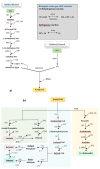Syngas Fermentation for the Production of Bio-Based Polymers: A Review
- PMID: 34833218
- PMCID: PMC8618084
- DOI: 10.3390/polym13223917
Syngas Fermentation for the Production of Bio-Based Polymers: A Review
Abstract
Increasing environmental awareness among the general public and legislators has driven this modern era to seek alternatives to fossil-derived products such as fuel and plastics. Addressing environmental issues through bio-based products driven from microbial fermentation of synthetic gas (syngas) could be a future endeavor, as this could result in both fuel and plastic in the form of bioethanol and polyhydroxyalkanoates (PHA). Abundant availability in the form of cellulosic, lignocellulosic, and other organic and inorganic wastes presents syngas catalysis as an interesting topic for commercialization. Fascination with syngas fermentation is trending, as it addresses the limitations of conventional technologies like direct biochemical conversion and Fischer-Tropsch's method for the utilization of lignocellulosic biomass. A plethora of microbial strains is available for syngas fermentation and PHA production, which could be exploited either in an axenic form or in a mixed culture. These microbes constitute diverse biochemical pathways supported by the activity of hydrogenase and carbon monoxide dehydrogenase (CODH), thus resulting in product diversity. There are always possibilities of enzymatic regulation and/or gene tailoring to enhance the process's effectiveness. PHA productivity drags the techno-economical perspective of syngas fermentation, and this is further influenced by syngas impurities, gas-liquid mass transfer (GLMT), substrate or product inhibition, downstream processing, etc. Product variation and valorization could improve the economical perspective and positively impact commercial sustainability. Moreover, choices of single-stage or multi-stage fermentation processes upon product specification followed by microbial selection could be perceptively optimized.
Keywords: carbon monoxide dehydrogenase; fermentation; hydrogenase; polyhydroxyalkanoates; syngas.
Conflict of interest statement
The authors declare no conflict of interest.
Figures




References
-
- Acharya B., Roy P., Dutta A. Review of Syngas Fermentation Processes for Bioethanol. Biofuels. 2014;5:551–564. doi: 10.1080/17597269.2014.1002996. - DOI
-
- Daniell J., Köpke M., Simpson S. Commercial Biomass Syngas Fermentation. Energies. 2012;5:5372–5417. doi: 10.3390/en5125372. - DOI
-
- Sun X., Atiyeh H.K., Huhnke R.L., Tanner R.S. Syngas Fermentation Process Development for Production of Biofuels and Chemicals: A Review. Bioresour. Technol. Rep. 2019;7:100279. doi: 10.1016/j.biteb.2019.100279. - DOI
-
- Couto N., Rouboa A., Silva V., Monteiro E., Bouziane K. Influence of the Biomass Gasification Processes on the Final Composition of Syngas. Energy Procedia. 2013;36:596–606. doi: 10.1016/j.egypro.2013.07.068. - DOI
-
- Drzyzga O., Revelles O., Durante-Rodríguez G., Díaz E., García J.L., Prieto A. New Challenges for Syngas Fermentation: Towards Production of Biopolymers: New Challenges for Syngas Fermentation. J. Chem. Technol. Biotechnol. 2015;90:1735–1751. doi: 10.1002/jctb.4721. - DOI
Publication types
LinkOut - more resources
Full Text Sources
Other Literature Sources

